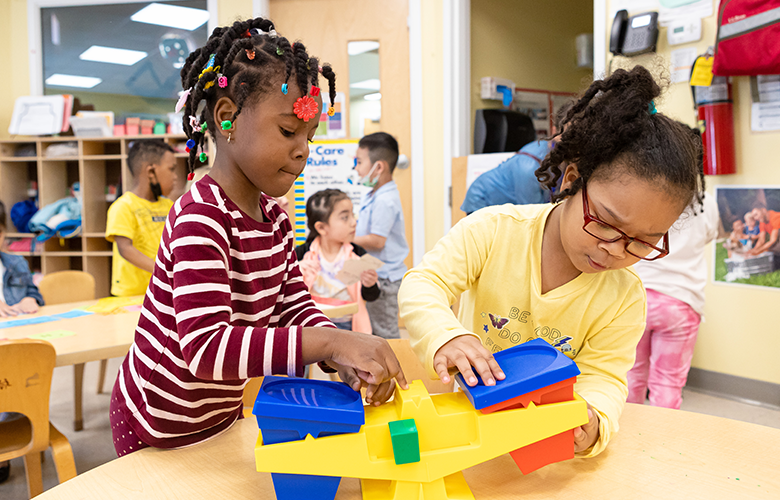
This post is an excerpt of a post published on the Institute of Education Sciences (IES) Regional Educational Laboratory (REL) Northeast & Islands blog on April 1, 2024. It is reprinted here with permission from IES.
Many educators across the United States—including those in the U.S. Virgin Islands—have raised concerns that the increased focus on standards and testing may be lessening the amount of singing, laughing, and playing in early childhood classrooms. In 2019, the U.S. Virgin Islands (USVI) legislature passed USVI Act 8270, which required all prekindergarten (preK) through grade 3 teachers to obtain early childhood certification. When our Regional Education Laboratory (REL) Northeast & Islands team began to discuss how to support teachers in meeting the requirements of Act 8270 with administrators and educators on the islands, we learned that bringing joy back to early childhood classrooms is a key priority. This blog explores the value of joyful learning and shares some play-based strategies for educators that have come out of our work with the U.S. Virgin Islands.
Why is joyful learning through play important?
Educational researchers have identified six key skills needed for success in today's workplace and world—collaboration, communication, content, critical thinking, creative innovation, and confidence.1 Play and other joyful learning strategies help develop these 21st century skills. According to the National Association for the Education of Young Children, play also supports development across developmental domains.2 Through play, students practice oral language skills, test their physical abilities, develop cognitive understanding, and interact with their peers.
Play builds on other pedagogical best practices, such as allowing children some control over their learning and environment. In play, children have the freedom to explore and try new things. Furthermore, the social-emotional development fostered by play cannot be overstated. Play is inherently social, encouraging children to communicate, challenge both their own and others' ideas, and develop the ability to interact, create, and collaborate successfully.
What do playful classrooms look like?
Because research evidence on the importance of play for healthy development is so extensive, the American Academy of Pediatrics recommends play be integrated into the school setting.3 But how do educators cultivate play? Playful classrooms share several key characteristics.
Playful classrooms are full of joy.
Joyful classrooms lead students to develop a deeper understanding of the learning material. Research shows that learners are more likely to remember what they enjoy, meaning play creates lasting understanding.4 Children do better in school when they enjoy learning, making play an important aspect of any classroom. Through guided play, teachers can skillfully connect playful activities to specific learning content, making learning relevant and relatable. It's a simple fact: We remember better the things that we enjoy more vividly.
Playful classrooms make learning accessible for all students—regardless of age or ability.
Children's brains change during play as new neural pathways are forged, making play an extremely accessible way to teach. And all students can participate and grow through play, regardless of their abilities or developmental stage. This is particularly important in early childhood classrooms, where attention spans are just beginning to develop—these younger students are more attentive and involved when the learning process is interactive and fun.
Classroom play is iterative.
Students get the chance to test out and refine their ideas and hypotheses (e.g., Will this tower stand? Will this block make it better or worse?). For example, in one study, children as young as two were able to figure out which combinations of blocks would make a music box play, given the opportunity to experiment and iterate.5 This approach not only enhances learning but is also accessible to very young learners, even those as young as 16 months.
Playful classrooms follow students' interests.
A playful environment allows children to pursue their own learning opportunities more independently, which can lead to greater learning. In another study, researchers asked children to play with a complex toy that did all sorts of things. Children who were told how to play with the toy, only played with the toy in that way.6 Children who were just given the toy without any adult instructions found many more ways to play and interact with the toy—and even found a secret squeaker mechanism that the adults didn't tell them about. In other words, letting children explore on their own can lead to better and richer learning.
To continue reading, see the full post on the Institute of Education Sciences blog.
| Anne Huntington advances knowledge of strategies to improve the well-being of students, educators, and families in the United States and abroad. Her primary interests are elementary curriculum and implementation. | |
| Joy Lorenzo Kennedy is a developmental psychologist with expertise in research and evaluation. She advances knowledge of strategies to promote early language and literacy development, school readiness, and family engagement.
|
1Hirsh-Pasek, K., Golinkoff, R. M., Nesbitt, K., Lautenbach, C., Blinkoff, E., & Fifer, G. (2022). Making schools work: Bringing the science of learning to joyful classroom practice. New York: Teachers College Press.
2National Association for the Education of the Young Child. (2020). Developmentally appropriate practice (DAP) position statement. https://www.naeyc.org/resources/position-statements/dap/contents.
3Yogman, M., Garner, A., Hutchinson, J., Hirsh-Pasek, K., Golinkoff, R. M., Baum, R., & Committee on Psychosocial Aspects of Child and Family Health. (2018). The power of play: A pediatric role in enhancing development in young children. Pediatrics, 142(3). https://publications.aap.org/pediatrics/article/142/3/e20182058/38649/The-Power-of-Play-A-Pediatric-Role-in-Enhancing
4Savina, E. (2014). Does play promote self-regulation in children? Early Child Development and Care, 184(11).
5Gopnik, P. (2012). Scientific thinking in young children: Theoretical advances, empirical research, and policy implications. Science, 337(1623). https://www.brianesty.com/ScientificThinking
6Bonawitz, E. Shafto, P., Gweon, H., Goodman, N.D., Spelke, E., & Schulz, L. (2011). The double-edged sword of pedagogy: Instruction limits spontaneous exploration and discovery. Cognition, 120(3), 322–30.


Comments
Add new comment